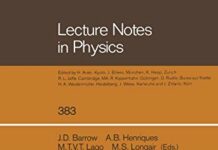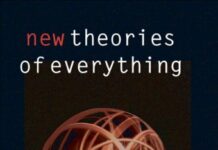
Ebook Info
- Published: 1988
- Number of pages: 738 pages
- Format: PDF
- File Size: 13.46 MB
- Authors: John D. Barrow
Description
Ever since Copernicus, scientists have continually adjusted their view of human nature, moving it further and further from its ancient position at the center of Creation. But in recent years, a startling new concept has evolved that places it more firmly than ever in a special position. Known as the Anthropic Cosmological Principle, this collection of ideas holds that the existence of intelligent observers determines the fundamental structure of the Universe. In its most radical version, the Anthropic Principle asserts that “intelligent information-processing must come into existence in the Universe, and once it comes into existence, it will never die out.” This wide-ranging and detailed book explores the many ramifications of the Anthropic Cosmological Principle, covering the whole spectrum of human inquiry from Aristotle to Z bosons. Bringing a unique combination of skills and knowledge to the subject, John D. Barrow and Frank J. Tipler–two of the world’s leading cosmologists–cover the definition and nature of life, the search for extraterrestrial intelligence, and the interpretation of the quantum theory in relation to the existence of observers. The book will be of vital interest to philosophers, theologians, mathematicians, scientists, and historians, as well as to anyone concerned with the connection between the vastness of the universe of stars and galaxies and the existence of life within it on a small planet out in the suburbs of the Milky Way.
User’s Reviews
Editorial Reviews: Review `an engaging book … practically a universal education in both the history of modern science and the history of the Universe … will be much quoted, much debated and much praised’ Nature`a feast: the kind of book which tells you everything you want to know about everything’ The Economist`I was infuriated by it, disagreed with it and loved reading it.’ Timothy Ferris, New York Times Book Review`in the speculative and intellectual richness of its pages, this book is probably unsurpassed’ Peter Atkins`a masterly exposition of what seems bound to become one of the most important developments to have taken place in physical science’ TLS`Intriguing analysis of new scientific thinking.’ Sydney Times`unique and wide-ranging book … The reader is taken on an eclectic study of many scientific disciplines and is presented with a revealing picture of the structure of the physical world solely in terms of its invariant constants. There are also fascinating chapters on the definition and nature of life, the search for extra-terrestrial intelligence and the interpretation of quantum theory in relation to the existence of observers.’ Europe & Astronomy 1992`If you get a kick out of cosmic coincidences The Anthropic Cosmological Principle … is definitely for you. The “anthropic” idea, which is that our very existence may explain why the Universe is the way it is, is an extraordinary one. So too is Barrow and Tipler’s account.’ New Scientist From the Back Cover In their classic work, John Barrow and Frank Tipler examine the question of mankind’s place in the Universe, taking the reader on a tour of many scientific disciplines and offering fascinating insights into issues such as the nature of life, the search for extraterrestrial intelligence, and the history and fate of our universe. About the Author John D. Barrow is University Lecturer in Astronomy at the University of Sussex, England.Frank J. Tipler is Professor of Mathematical Physics at Tulane University, New Orleans. Read more
Reviews from Amazon users which were colected at the time this book was published on the website:
⭐Any college graduate should know there would be no life let alone intelligent life on earth if we were not located at a specific distance from a G2 star on a planet well endowed with water and the basic chemicals and timescale required for the evolution of carbon based life forms. The reason I bought this text was from several references with cited it as listing a host of other improbable cofactors related to the formation, physics, chemical properties and time lapse of the universe required for the evolution of mankind to a point that we can even attempt to understand the universe and the world in which we live. Those factors are very well elaborated and described. We are indeed fortunate to be alive.This was a long difficult read for me requiring a great deal of thought and reference work. Some sections related to physics and math were simply beyond my understanding in spite of a strong postgraduate science base and attempts to keep abreast in advances in science. I could work through much of the math but quantum physics and cosmology have advanced well beyond my education and a fair amount of subsequent readings in these fields. This was the rare book I enjoyed in spite of having to pass over a few chapters and sections. My interest and knowledge in biology and chemistry made these chapters very rewarding and informative pulling together many issues I had never before considered. I was one of those rare college students who was fascinated by biochemistry and those sections alone were well worth the read. Frankly the extensive side work required to understand many of the arguments was also a positive. The knowledge base of the authors not only in the various science disciplines but also in history and philosophy is extraordinary. Recognize a great deal of advancement in science has occurred since the first edition of the book in 1986.While I hesitated to share this book with my son who majored in the arts, philosophy and theology due to his lack of interest and education in science much beyond Newtonian physics and Mendel’s genetics I will do so because an understanding of the limits of our personal knowledge base is critical as has been so throughly demonstrated since the 2016 elections in the USA.Not sure I share the optimism of the authors with the advancement and potential of the human species, critical factors in accepting the conclusions of the authors. Nevertheless, anyone who fails to read the book based on their preconceived ideas of design, lack of design or purpose of the universe will be missing a major intellectual work of value.
⭐I had a copy of an early edition of this book, but it was borrowed by a friend who promptly moved to another province… Now I’ve refilled that gap on my shelf with an uptodate edition of this comprehensive and detailed thesis. The footnotes at the end of each chapter would themselves fill a small library. Don’t worry about the little bits of math, most of the text is easy reading. Recommended for anyone looking for an overview of cosmogony and our part in it.
⭐This is an amazing book about an amazing concept but it is also amazingly complicated to read. The authors combine a whole universe of thought into a 700 page long argument on why we exist and what our purpose is in the universe. This book is about the Anthropic Cosmological Principle which is the philosophical argument that observations of the physical universe must be compatible with the conscious life that observes it. Barrow and Tipler outline in this book that the Anthropic Principle explains why the Universe has the age and the fundamental physical constants necessary to accommodate conscious life.The authors differentiate between the Weak Anthropic Principle (WAP), which states that the observed values of all physical and cosmological quantities are not equally probable but they take on values restricted by the requirement that there exist sites where carbon-based life can evolve and by the requirements that the universe be old enough for it to have already done so, and the Strong Anthropic principle (SAP) which assumes that the Universe must have those properties which allow life to develop within it at some stage in its history and that observers are necessary to bring the Universe into being.Key “Anthropic drivers” are Gravity, the Electro-Magnetic Field Forces, the Weak and Strong forces, the Ratio between the Masses of Electrons and Protons (1836), the Fine Structure constant (137), the Planck Constant, The Coulomb Constant, The Cosmological Constant, the Total Mass in the Universe, The Hubble Constant, The Flatness of the Universe and of course the speed of lightIn their argumentation they use the following very impressive gamut of tools from Physics and Mathematics: Tensor Operators, Non Euclidian Geometry, Mathematical Algebraic Topology, General Relativity, Schrodinger’s Equations, Heisenberg’s uncertainty Principle, Minkowski’s Space-Time Geometry, Gauge Symmetry, Occam’s Razor, Friedman’s Equations for the Universe, The Cosmic Microwave Background Radiation, von Neumann Probes, Darwin’s Origin of Species, Boltzmann’s Entropy, Hawkins’ Black Hole Thermodynamics, The Heat Death of the Universe, The Higgs Field, Poincare’s Recurrence Theorem, Turing Machines, Shannon’s Laws on Information and a lot more.The authors further explore the Physics underpinnings of Chemistry and through Mendeleev’s periodic Table, Bohr’s Quantized Atomic Model, The Pauli Exclusion Principle, The van der Waals and explain the anthropic significance of the very unique properties of Carbon, Oxygen, Water, Carbon Dioxide and even Iron.All of this is set in a philosophical framework about Teleology, which holds that final causes exist in nature, meaning that design and purpose analogous to that found in human actions are inherent also in the rest of nature. The authors take us on a wonderful journey through philosophy in which we encounter Aristotle, Plato, Socrates, Aquinas, Bacon, Descartes, Spinoza, Kant, Hegel, Russell, Marx and many more.This is the best researched book which I have read on this subject and after the long and hard read I agree that we are here for a reason and with purpose.
⭐Want a full on brain workout – read this. If you like interdisciplinary reads, this is definitely for you, but it needs reading slowly and over a period of months (may be even years!) It’s just too dense to sit down and take in over a nice cup of morning coffee!
⭐Great product, swift delivery. Thanks.
⭐This book will blow your mind! Recommended for those looking for enlightenment!
⭐Heavy reading. Enjoyable, but it was a struggle to finish. That said, excellently well written. The best books require a ton of thinking and that’s one of them.
⭐still reading it. excellent
Keywords
Free Download The Anthropic Cosmological Principle (Oxford Paperbacks) in PDF format
The Anthropic Cosmological Principle (Oxford Paperbacks) PDF Free Download
Download The Anthropic Cosmological Principle (Oxford Paperbacks) 1988 PDF Free
The Anthropic Cosmological Principle (Oxford Paperbacks) 1988 PDF Free Download
Download The Anthropic Cosmological Principle (Oxford Paperbacks) PDF
Free Download Ebook The Anthropic Cosmological Principle (Oxford Paperbacks)



